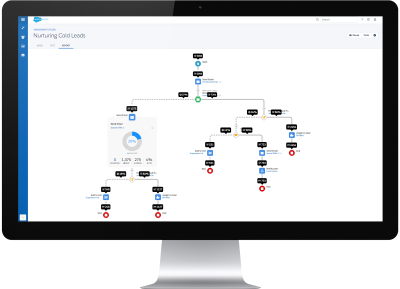


Planning your Pardot implementation
14 July, 2016
Beginning the journey towards implementing marketing automation technology is exciting and, as with all things new, contains a few unknowns. Here at LavaBox we've been around the Pardot block a few times and have some useful suggestions to help you plan for your implementation.
What do I want to achieve?
Pardot is an immensely powerful tool lending itself to almost endless applications, so deciding where to start can be daunting. Here's a few suggestions to get you off the mark:
- Lead generation - building landing pages, Pardot forms, A/B testing etc
- Lead qualification - scoring, grading, progressive profiling
- Lead management - segmentation, lead assignment, Lead nurture, CRM integration.
- Email Marketing - building emails, nurture campaigns, email personalisation, A/B testing
- Sales Intelligence - sales enablement, one-to-one emails, Salesforce engage
- ROI Reporting - closed loop reporting, email reporting, customer lifecycle reporting
Tackling all of these in at once could be biting off more than you can chew. Instead prioritise the 2-3 most important to your organisation then work your way through them accordingly.
Where in the customer lifecycle should I focus on?
Your customers are all on a journey. Every business's customer lifecycle is different, but generally a typical customer journey can be broken down into:
- Researching - learning about their problem by consuming educational content
- Short listing - deciding on potential providers, making enquiries, having initial sales conversations
- Selecting - choosing between alternatives by viewing case studies, checking references, reviewing proposals and technical data
- Experiencing - becoming a customer, learning to use the solution, reviewing and referring
- Upgrading - buying additional products or services
- Leaving - back to researching
Ask yourself the question, "If I could move a customers from one stage of their journey to the next, where would I see the strongest commercial win?" Then decide on two priority campaigns that focus on different areas of the customer lifecyce for your initial implementation.
Example: If you focused on the "researching" stage, you'd be developing a campaign that captured the details of early stage researchers in return for a key piece of educational content. This would then flow into a drip campaign to nurture them until they're ready to move to the "shortlisting" stage and speak with a salesperson.
Who should I involve?
Pardot really is a collaboration of marketing and sales. It provides the opportunity for marketing and sales teams to work much closer together than they once would have.
While being a relatively easy software product to use, it does require some technical knowledge initially to ensure your systems collaborate and operate efficiently.
Consider including the following people through-out your implementation:
- Marketing team - Generally, the marketing manager will lead the implementation, however other members of the marketing team who are responsible for executing digital campaigns can also be involved.
- Sales leader - Sales teams often look at Pardot as a marketer tool only. Realistically it gives "marketing power" to the sales team by allowing marketers to design campaigns that support the sales process. It's not always possible to have a sales leader present for the duration of your implementation, so ensure you find the time to consult together understand their sales processes and what they want marketing to deliver.
- Salesforce admin - If you do not have one in-house, ensure you have the technical guidance to connect Pardot to Salesforce and get the two systems talking effectively.
What content will I need?
Firstly, what do you already have? One of Pardot's strengths is recycling existing content that once would have died on the vine.
Engage your sales team by getting their perspective on what kinds of content would help address their customers' buying considerations. This is also a good chance to ensure you understand their sales process from end-to-end. There's no use developing marketing automation that doesn't enhance the customer's buying experience and help reps close deals.
Review historical marketing assets and cherry-pick content that is still relevant and can be re-used or re-tooled easily. To get you underway consider any existing:
- Sales collateral
- Video content
- Newsletter content
- Blogs
- Case studies/testimonials/Project portfolio
- Landing pages
- Social media content
- Whitepapers
- Infographics
- Webinar recordings
One final aspect to consider, is that all content doesn't have to be proprietary. Helpful content that's been developed by third parties can be distributed throughout your campaigns e.g. a relvant industry article from a major news site.
How much time will I have to allocate to Pardot?
Pardot Quick Starts run for 8 weeks total and during that time our weekly sessions will cover as much as you need. At the conclusion of each session, your Pardot consultant will assign some key objectives to work on and complete before the next session.
The actual time investment required will vary depending on your objectives. It's always recommended to consider not only your availability but that of your team's also. As a rough guide between 10 - 30 hours per week is a good amount of time to invest in the technical implementation. New content should be briefed in as early as possible to your creative team, and can be slotted into campaigns when ready.
Related articles
Using Marketing Automation Across the B2B Customer Journey
05 February, 2016
There's a tendency to think the only use case for marketing automation is at the front of the sales funnel. In reality, marketing automation can become the glue that ties the entire customer journey together. From lead generation and nurturing, through to re-engagement, solution selection, customer onboarding, and proactive account service. Let's take high level look at how marketing automation can enhance the customer experience and drive revenue throughout the customer lifecycle:
MoreHow marketing automation transforms cold calling
10 August, 2015
Cold calling doesn’t work too well with complex sales for a few reasons. First, you have to get lucky - calling a prospect who actually cares about the problem you’re trying to solve at the moment you’ve contacted them. Second, you have to educate them - around who you are, the problem they have and how you’re uniquely positioned to help them solve it. Third, you have limited time - they didn’t ask for the call, and understanding your complex proposition probably isn’t on their list of priorities that day.
More5 Lead nurturing campaigns to convert your prospects into contracts
01 September, 2016
Lead nurturing empowers marketers to craft tailored content journeys that take prospects down different routes based on their actions (like clicking through on email links) or data profile in Salesforce (like their lead score or industry vertical). These campaigns deliver content that supports the sales process and influence prospects throughout the customer journey. Below are five lead nurturing campaigns that help move prospects from "new lead" through to "contract signed."
MoreLevel 2 - 224 Symonds St
Eden Terrace
Auckland 1024







